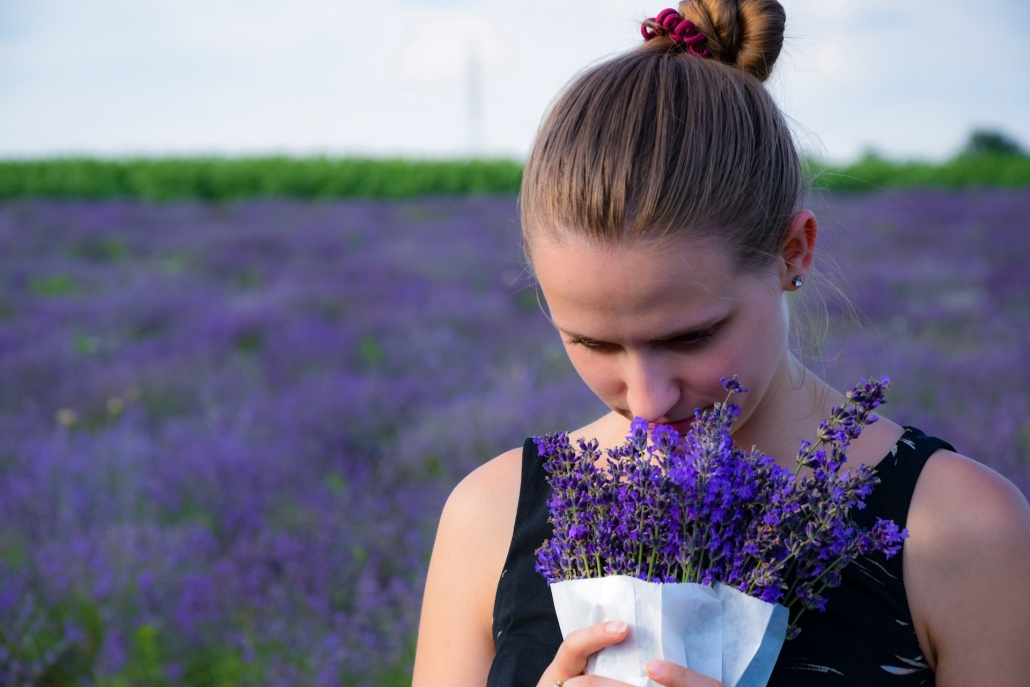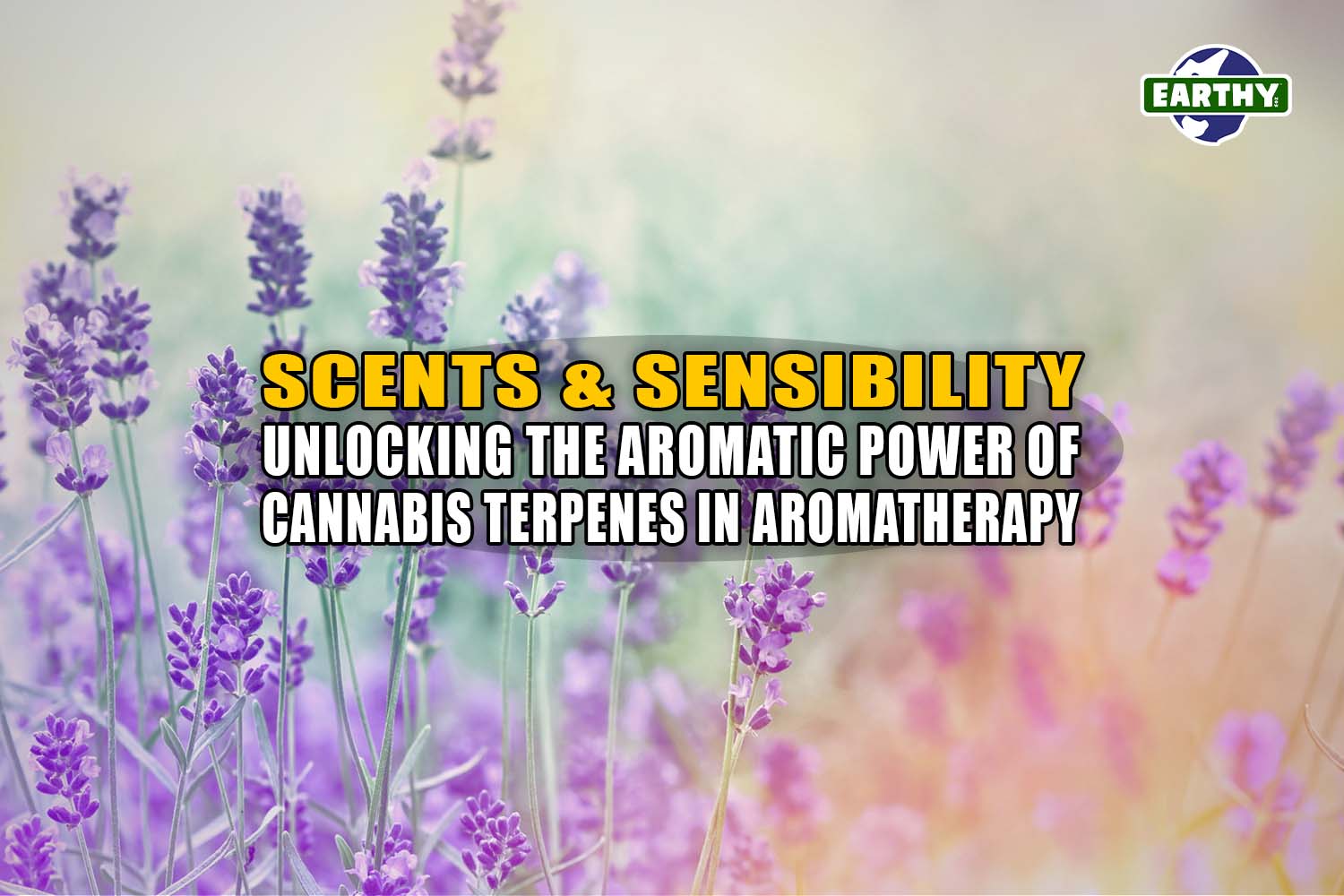Aromatherapy has long been a cherished practice for those seeking natural and holistic remedies. The practice utilizes essential oils derived from many plants. Arguably, aromatherapy can promote wellness benefits, and as some claim, even immune system support [1]. Recently, the world of aromatherapy has expanded to include cannabis terpenes, marking a new frontier in herbal practices. Indeed, many recognize these naturally occurring compounds for their potential to enhance well-being through their aromatic profiles and wellness benefits [2]. This article explores how cannabis terpenes in aromatherapy unlock new dimensions of healing, offering an innovative blend of tradition and modern science.
Understanding terpenes and their role in aromatherapy
Terpenes are aromatic compounds found in many plants, including citrus plants, herbs, and the cannabis plant. Notably, these volatile compounds offer the distinctive scents that we associate with various essential oils [1]. In the context of cannabis, cannabis strains of both the cannabis sativa and indica varieties produce terpenes. As such, they not only define the plant’s aroma but also contribute to its aromatherapy benefits [2].
Cannabis produces a wide array of terpenes, each with its own unique terpene profile. As such, these terpenes play a significant role in the plant’s interaction with the human body, particularly through the endocannabinoid system (ECS). This system, which includes endocannabinoid receptors, is crucial in helping regulate various physiological processes, including pain perception, mood, pleasure, and the immune response [3].
Cannabis terpenes in aromatherapy and the entourage effect
In aromatherapy, terpenes contribute to the wellness properties of essential oils by interacting with the endocannabinoid system and other pathways. According to some researchers, terpenes can potentially stimulate the immune system, reduce inflammation, and alter mood by engaging cannabinoid receptors. Additionally, some experts claim, that when combined with other cannabis compounds, these terpenes may influence the effects of natural cannabinoids like THC and CBD. This interaction, known as the entourage effect, highlights how cannabinoids and terpenes may work together to amplify the overall benefits of the plant [4].
However, other researchers argue that there is not enough evidence to support these theories [5].
Guide to Cannabis-Derived Terpenes
Key terpenes and their potential wellness benefits
Each cannabis strain has a unique terpene profile that determines its signature scent and potential wellness properties [2]. Here are some of the most common terpenes found in cannabis plants and their potential benefits:
1. Myrcene
- Aroma: Earthy, musky, with a hint of cloves.
- Potential wellness benefits: Some researchers suggest that myrcene may have properties that could aid anti-inflammatory, pain-relieving, and muscle spasm-relieving effects [6]. However, other researchers argue that there is insufficient evidence to support these claims [5]. Thus, consumers interested in utilizing myrcene should consult a physician for guided treatment options.
- Found in: Certain cannabis strains, mangoes, thyme, and lemongrass [6].
2. Limonene
- Aroma: Citrusy, similar to citrus fruits.
- Potential wellness benefits: While some experts claim that limonene may relate to stress relief, elevated mood, and anti-fungal properties, others maintain that there is not enough proof of its efficacy [7, 5]. Thus, more research is necessary to verify this theory.
- Found in: Citrus plants, peppermint, and juniper [7].
3. Linalool
- Aroma: Floral, lavender-like.
- Potential wellness benefits: Though many people claim that the lavender-like scent of linalool is indeed calming, experts have debated claims that it has anti-inflammatory effects and pain relief properties [5]. Thus, individuals seeking these qualities should consult a healthcare professional for guided treatment.
- Found in: Lavender, coriander, and certain cannabis strains [8].
4. Pinene
- Aroma: Pine-like, fresh.
- Potential wellness benefits: Some researchers suggest this terpene offers anti-inflammatory properties, improved focus, and respiratory support [9]. Though it is often used in cough drops and cold medicine, some experts argue that the evidence supporting some of these claims is insufficient [5]. Thus, individuals seeking these effects should consult a healthcare professional.
- Found in: Pine trees, rosemary, and many cannabis cultivars [9].
5. Caryophyllene
- Aroma: Spicy, woody, with a peppery aroma.
- Potential wellness Benefits: Though some researchers highlight its potential as an anti-inflammatory agent for pain relief and its potential benefits for pain perception, others argue that there is not enough evidence to support these claims [9, 5]. Thus, it’s crucial to consult a physician for individualized treatment for specific conditions.
- Found in: Black pepper, cloves, and certain terpenes in cannabis [9].

Assessing which terpenes to use
These terpenes not only define the aromatic profiles of various cannabis strains but also may offer potential wellness benefits harnessed through aromatherapy. For example, cannabis users seeking stress relief might opt for a terpene-rich cannabis strain with high levels of linalool or limonene, while those looking for relaxation and comfort might prefer cannabis products rich in myrcene or caryophyllene [2]. However, these purported effects are controversial and should not be taken as fact [5]. Thus, individuals interested in certain cannabis terpenes for aromatherapy should weigh the evidence to make informed decisions.
Top 20 Cannabis-Derived Terpenes
Scientific evidence supporting cannabis terpenes in aromatherapy
The cannabis industry increasingly focuses on the potential of cannabis-derived terpenes in aromatherapy. Indeed, current research has begun to explore how these aromatic compounds can be used to enhance wellness beyond the psychoactive effects typically associated with Delta-9 THC from marijuana or hemp [4].
Notably, studies have shown that certain terpenes found in cannabis offer promise for the future of cannabis-derived medicine [4]. For instance, pinene has been found to improve cognitive function and reduce inflammation in animal studies, while limonene has demonstrated significant antioxidant activity in trials [10, 11]. These findings suggest that cannabis terpenes may be harnessed in the future as medicinal agents. However, we have yet to see what the future holds for these terpenes in medicine.
Moreover, the entourage effect—the theory that cannabinoid compounds work better together than in isolation—supports the idea that terpenes can enhance the effects of natural cannabinoids. This synergy is particularly relevant in aromatherapy, where the combined impact of terpenes and cannabinoid compounds could provide a more holistic approach to healing [4].
Premium sources for cannabis products
For cannabis enthusiasts seeking the best CBD products and robust terpenes, Earthy Now has something for everyone.
Explore these popular products from Earthy Now:
- Terpenes
- CBD Flower
- Gummies
- Lozenges
- Tablets (THC Free!)
- Soothing Relief Lotion
- Soothing Relief Salve
- CBD Pet Tinctures (no THC!)
- Oils
- Pre-Rolls
- Smokes
How Do Terpenes Affect Your High?
Practical applications and considerations
Individuals can incorporate cannabis terpenes in aromatherapy in several ways. For example, steam distillation is a common method for extracting essential oils and terpenes from the cannabis plant [12]. As a result, individuals can use these terpenes in diffusers, add them to bath blends, or apply them topically for targeted aroma-based therapeutic benefits.
However, it is important to consider the terpene profile of each cannabis strain and the desired therapeutic properties when selecting cannabis products for aromatherapy. For instance, a terpene composition high in myrcene may be more suitable for relaxation and sleep, while one rich in limonene might be better for mood enhancement [2]. However, not everyone experiences these outcomes, as cannabis and cannabis terpenes affect individuals differently. Also, evidence supporting these claims may be insufficient to draw conclusions [5].
High Impact: How Cannabis Activists Are Changing the Legal Landscape
Be sure to choose quality products
Also, cannabis consumers should be aware of the potential risks associated with using cannabis terpenes in aromatherapy. While terpenes are generally safe, high concentrations of certain volatile compounds can cause irritation or allergic reactions in sensitive individuals [13]. Additionally, individuals should carefully consider the quality and purity of cannabis products, as contaminants can affect the efficacy and safety of the aromatic molecules. Thus, terpene enthusiasts should choose reputable sources like Earthy Now that offer third-party lab reports and deploy safe, ethical practices.
The future of cannabis terpenes in aromatherapy
The integration of cannabis terpenes into aromatherapy represents a significant advancement in the field of herbal medicine. Indeed, as cannabis researchers gain footing, we can expect to see an increasing number of cannabis products designed specifically for aromatherapy, offering cannabis users new ways to experience the potential medicinal benefits of these naturally occurring compounds.
Moreover, as the cannabis industry continues to grow, the development of terpene-rich cannabis strains tailored for aromatherapy could become a major component of consumer preference. Indeed, this evolution will likely lead to a broader acceptance of cannabis terpenes in mainstream wellness practices, bringing the therapeutic benefits of this versatile plant to a wider audience [14].
Key takeaway: cannabis terpenes in aromatherapy
In conclusion, cannabis terpenes are unlocking new possibilities in aromatherapy, offering a bridge between ancient healing practices and modern scientific understanding. Whether for relief, or simply to enjoy the distinctive scents of cannabis, these aromatic compounds are poised to revolutionize the way we approach holistic wellness.
Visit Earthy Now for a wide selection of cannabis terpenes and other premium cannabis products!
Medical Disclaimer / Legal Disclaimer – Information is provided for educational purposes. It does not and is not intended to constitute legal advice or medical advice. We attempt to be accurate and up-to-date, but the legality of cannabinoids and the science of cannabis are evolving. The author is neither a legal professional nor a medical expert. Before buying or using any products, you should check with your local authorities and medical providers.
References
- What Is Aromatherapy?
- Exploring the Power of Cannabis Terpenes
- Terpenes in Cannabis, Explained
- The “Entourage Effect”: Terpenes Coupled with Cannabinoids
- Some of the Parts: Is Marijuana’s “Entourage Effect” Scientifically Valid?
- Myrcene—What Are the Potential Health Benefits of This Flavouring and Aroma Agent?
- Limonene: Effects and Benefits
- Linalool Profile
- What Is a Terpene & How Do They Work?
- Alpha-Pinene Ameliorates Inflammatory Mechanism In Rat Study
- The Antioxidant Activity of Limonene
- What Are Steam-Distilled Terpenes?
- Is It Possible to Be Allergic to Cannabis (Weed)?
- The Future of Terpenes in Cannabis Product Development




 Earthy Now
Earthy Now Earthy Now
Earthy Now